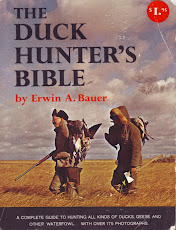
I decided to make this post about the Quail Flats Gunning Boxes that I make. Perhaps you have seen the photo on the sidebar. The picture at right is what got this whole thing going. It is still the one I use every hunting season, since about 1979 or so.
It all begin when my brother gave me this replica, of a "Chesapeake Bay Gunning Box" as a gift back in the late 70's. This box was not an original, yet it had been distressed and weathered to look as if it were an antique. The cool thing about my brother is that we usually get each other gifts, that we would like for ourselves.He realized after I started using it just how convenient it was to have all my shotgunning accessories in one location. So not long after he gave it to me, did he ask if I thought I could make one. The writing was clearly on the wall and my friends were also becoming more interested in acquiring one for themselves.
Hence, the humble beginnings of building somewhat rustic and crude versions of the original. I tried different types of hardwoods and softwoods in search of an ideal balance between strenght, durability and being aesthetically pleasing to the eye. The one I received is made of Fir or Pine I believe, and has cut outs in the ends of the box to use for handles. The lid opens to 180 degrees and is held on by strapping hinges. A basic hasp is the closure for the lid and there was not a clip or snap supplied, so I attached one myself to hold the lid closed. It struck me that there was room for improvement regarding the handles, hinges and hasp closure. I felt that the size of the box and its interior tray, were ideal given its usage. Which leads me to a bit of history about this item.

There is not much information about "Gunning Boxes" purse' other than they were used for holding ammo and related items for shotgunning. The earliest records I was able to find were dated back to the 1870's. These days there are companies producing ammo boxes, yet those are different from a true Gunning Box. Also when you mention Gunning Box people often think it is used for storing your gun. Not so. Present day Gunning Boxes hold much more than just ammo. Mine has choke tubes, face camo, sharpening stone,steel, knife, duck and goose calls, cleaning kit, batteries, deck of cards, matches and that is just in the tray. Below the tray are 10 boxes of 20 ga. shells, gore tex gloves, fingerless gloves, hat, 7 x 32 leica binoculars, mag light, headlamp, gunning log, oil, tp, duct tape and dog biscuits. What is really great about these boxes is that everything stays in them year round. No more having to search your house, garage, closets etc. for this gear every Fall. With a Gunning Box you're always ready to go, just grab your vest, dog, decoys and hunting buddy.
After making more than a half dozen or so(with hand cut dovetails) and giving them as gifts to my hunting buddies, in 2001 I decided to refine my initial efforts and do some serious marketing. The end result is the photo below. There are over 100 steps in making a Quail Flats Gunning Box. From the initial selection of solid Cherry hardwood to the milling, routing, sanding, dovetailing, rabbeting, grooving, hand planing, more sanding, lacquering, and even addressing the solid brass hardware.
The hardware is all solid cast brass, meaning it is not stamped, pressed, cut or cheaply made in any way what so ever. Quite the contrary. The handles are made in England and have built in stops at 90 degrees to the box, so your knuckles don't get banged up by the box. The Brusso hinges are made in the U.S., machined from solid brass flat stock and have a stainless pin in the knuckle. They have a built in stop at approximately 95 degrees to support the lid/top in an upright position when open. Less chance of the top breaking by laying fully open at 180 degrees. Plus it makes a nice presentation and requires less space to open the top and access its contents. The hasp is a "Hook and Bail" type, which will not open on its own and is a very secure closure, U.S. made as well.
The top and bottom raised panels are from a single piece of Cherry and are not edge glued to make up their width. Finding wide Cherry is not a simple task, yet it is worth the effort. These raised panels are recessed in a groove that is a bit oversized than the panels themselves. This is to allow for wood movement (expansion & contraction) throughout the year. Just that happy medium from the old school of hand built furniture. The tray bottom is a single piece of Cherry too, and allowances made here for movement as well. The tray dividers are pinned with Cherry dowels and the darker end grain makes for a nice contrast on the front and back of the tray respectively.
In all I made approximately 75 Quail Flats Gunning Boxes. I made them in runs of 10 at a time. Each box requires approximately 5 to 7 hours from start to finish. Their dimensions are 22" L. x 9" W. x 9 and 5/8" H. The tray is 2 and 5/8" H. and nests mostly in the top, allowing for maximum storage below the tray. I marketed them online and also in Gray's Sporting Journal and Sporting Classics magazines. Most of my sales came from back East where there is more waterfowl history and recognition. Followed by the mid west for the same reasons. Lots of famous decoy carvers from both those areas, and museums dedicated to the preservation of waterfowl history. Over the years I have donated several Gunning Boxes to the Oregon Hunters Association, Ducks Unlimited and Pheasants Forever. It is just another way for me to give something back to this wonderful sport of hunting and to continue preserving the habitat for future generations.

I've had several customers request brass engraved initial/ name plates. Typically these are put on the inside of the lid /or on the tray front. Reason for this is so they don't get scratched or scuffed up from other gear being put on top of them. I have chosen Cherry for many reasons and here are a few; it was used for roofing shakes many years ago and is naturally resistant to bugs. It is a tight grained wood with a wide variety of colors and patterns. It is strong, but not to heavy and can take a bump or two without cracking or splitting. If the truth be known it is my favorite wood to work with. It is honest and to a degree, forgiving as well. Cherry also gets a patina over the course of time and becomes darker and richer in color. I have made these boxes in everything from Western Cedar to Honduras Mahogany, Walnut, Maple and Hickory.If you are interested in a Quail Flats Gunning Box, just drop me a note and I'll be glad to get one going for you. They will last for many generations and are built to honor a lifetime of memories.
Women's Hunting Journal Integrity For The Hunt








4 comments:
Those are absolutely beautiful. I don't have a need for a gunning box at present, but I want one just because they're gorgeous.
Thank you Kristine. You just let me know when you need one and we'll get the wheels turning.
Even though they're not the "bread winner" I had hoped for, it hasn't diminished my passion for building them. I really enjoy it a lot and it's still exciting for me.
Terry, those are some very nice looking boxes. As somebody who loves to work with wood I can relate to your handy work.
I am actually thinking of starting something similiar but, that is still a rough draft in my head.
I wish you all the luck with those boxes, I am sure they are worth every penny.
Thanks Rick, I am eager to hear more about your "hunting box".
Don't wait to long to start. As I learned with these Gunning Boxes, there is an evolution of refinement through out the process.
Post a Comment